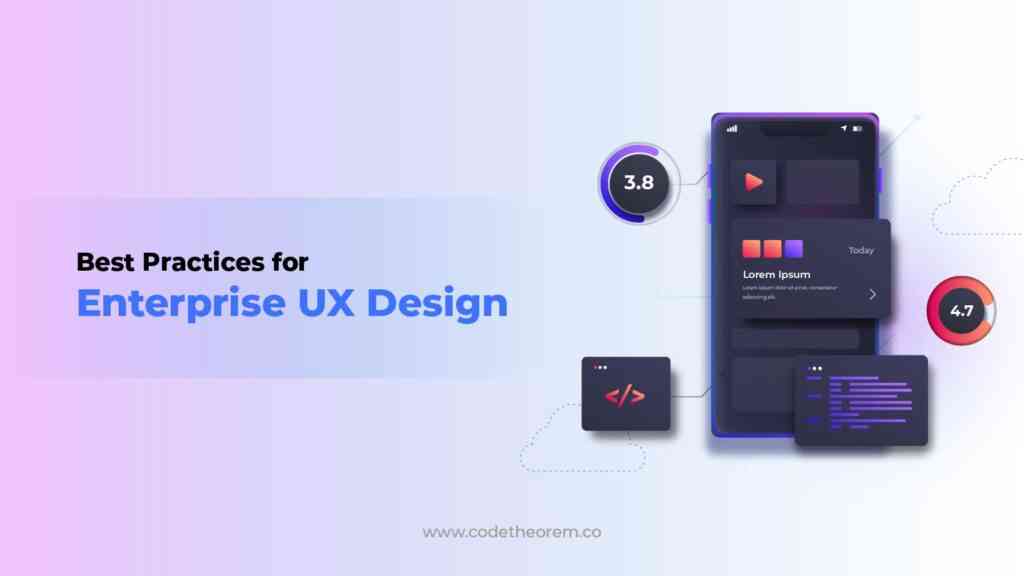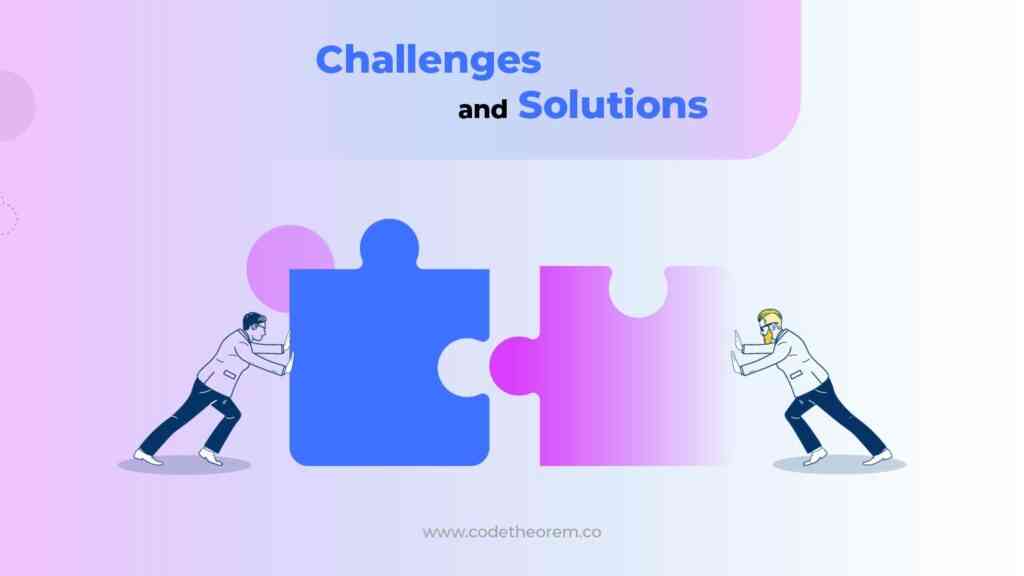What is the main aim of the internal solutions? It is to help people do more. But what if the solution becomes a problem? Enterprises are often worried about productivity, and great software with poor UX design hampers the work. The worst part is sometimes it goes unnoticed. But there is a way to stop these productivity-boosting solutions from becoming a hindrance. Enterprise UX.
Wondering what this blog has for you? Read to learn how to create simple experiences for enterprises via Enterprise UX. But before getting to that, it’s better to understand what exactly an enterprise UX is and its importance.
What is Enterprise UX Design

It all starts with the question: What is enterprise UX design? In simple words, it’s complicated. The term is new in the design industry. Thus there is no clear definition. Yet, there is one broad explanation. Unlike consumer UX, enterprise UX design patterns are particularly for working professionals. Following are a few examples:
- Internal software
- HR software
- Internal communications platforms
- Customer relationship management software
An enterprise software design or enterprise application design can be complex. For instance, every organization has different needs that you must address. As a UX designer, you must ensure that your client gets what they need without the hassle. In this case, your client is the enterprise. So, the enterprise can only work well if they have the right tools and software. This is where enterprise UX design patterns become important.
Importance of Enterprise UX Design

There are many reasons why enterprise research and the term are becoming so popular. Some of the leading organizations today see value in this domain. They look for the best software to work with. These tools and enterprise software design make the workforce more efficient. It also leaves a positive impact on the end-user. Following are some reasons why enterprise UX is essential:
1. Employee Satisfaction
When large organizations buy an enterprise software design, they want to know one thing. That is the effect it will have on their operations at work. Thus, the product or software must help them do their tasks. It should also make the employees feel good.
If the design is difficult to interact with, the employees will not engage with it. This will hinder the workflow. It will also affect sales and ROI. As a UX designer, you must ensure the value of 2 things while working on enterprise design. They are the employees’ experiences and emotions.
2. Better Internal Communication
How the employees communicate internally determines their efficiency and performance. And in today’s remote work culture, building a cooperative team is not something you can ignore. Thus, enterprise UX design can help to improve internal communication. But how? By including live chat and messaging features in your enterprise design.
3. Sales
Many organizations buy plans for marketing tools, SEO, CRM, and more. These products and services come under the definition of enterprise UX. That is because their target audience is also large enterprises. Therefore, the aim is to help organizations get more business, and sales, and gain an advantage.
A good enterprise UX is easy to use and adds value to an organization’s business. It enables organizations to manage customer relations easily. This helps them to effectively analyze the data. As a result, this turns into an advantage to improve their business model.
4. Customer Experience
Want to provide an excellent experience to an organization’s clients? Enterprise software design plays an important role here. A poor enterprise product design can lead to a bad experience for the user. Thus, you must ensure that the tool offers the best experience to both of them. That too, in the most straightforward way.
5. Better Performance
An organization’s employees use enterprise software for at least 8-10 hours a day. If the software is easy and swift to use, employees perform better. Moreover, the software must support user journey optimization and intuitive navigation. It helps them save time and increase productivity.
6. Easier Understanding
An enterprise software design must provide features for data visualization. Also, dashboards and an information-rich interface for easy and better understanding. This will help employees gather key insights quickly and make informed decisions.
Difference Between Customer UX and Enterprise UX

Understanding the importance of enterprise UX is vital. But it’s best to also understand the differences between consumer UX and enterprise UX.
Are you a UI or UX designer working with many projects at a time? It can get challenging for you to navigate between customer UX and enterprise UX.
The basic design principle stays the same. The enterprise UX strategy is similar to that of customer UX too. But there are some significant differences. They are as follows:
- Consumer applications you design are for a particular task. Whereas enterprise apps are for a business domain.
- Enterprise software design is complex. They may need to support many users and job functions. In contrast, consumer apps may need to perform only a single operation.
- For enterprise software design, the customers and users are different people. For consumer apps, the buyers are the users.
- Enterprise apps are configured by administrators, whereas the consumers themselves configure consumer apps.
- The users of enterprise apps are employees of an organization. They do not have a choice when selecting or using the apps. It is necessary to adhere to the rules of their organizations. They have to use the apps every day to perform their job. But, the users of consumer apps choose the apps they want to use and when to interact with them.
- Efficiency is of much more importance in enterprise apps as users work on it all day.
- Enterprise solutions deal with more data and transactions than consumer apps. Thus, they have more scope and scale.
- Enterprise software has more restrictions and strict security requirements than consumer apps.
Best Practices for Enterprise UX Design

There are some significant differences between consumer UX and enterprise UX. But the lines between the two are blurring. Luckily, designers are learning to keep up with the requirements. Furthermore, they are also learning to keep up with complex executions, and balance.
Here are some best practices for enterprise design systems.
Extensive Documentation:
Often, large teams use enterprise products. Thus, documentation is important to provide everyone with the same input. This keeps everyone on the same page.
Maintaining Consistency:
Usually, several teams are across various regions or offices. And they work on different projects. As a result, it may create some challenges. For instance, non-compliance with guidelines or inconsistency in design and functionality. Even a conflicting brand image.
Hence, you must adopt an enterprise-wide design system to address these challenges.
Easy to Understand:
The primary concern of enterprise software is efficiency. To achieve that, designers often end up trading ease of use. So, try balancing efficiency and learnability while working on an enterprise app design. For instance, you can guide the users by providing a tour or giving an overview of crucial information through an interactive approach.
Adhere to Enterprise Processes:
Many enterprises stick to unique processes. For instance, they could be concerned with privacy or legal requirements or security and internalization requirements. In that case, you must put in place some best practices or stick to a checklist.
Less Creativity:
Enterprise software design does not need you to be creative. It does not promote offbeat innovations. Since it is to help employees perform tasks easily, innovations may be a distraction. Thus, not serving its purpose.
Boost the productivity of your employees by hiring an enterprise UX Agency to update the user experience.
Challenges & Solutions for Enterprise UX Design

1. Specialization
You need expertise in designing tools, software, and services for enterprise product design. The needs of enterprises are different from those of regular consumers. They are always ready to spend a good amount of money on a product that can help increase their ROI.
Another UX challenge is that enterprises are less forgiving than consumers. If you cannot give them a solution that meets all their needs, they won’t take long to find an alternative solution.
2. Context
You must clarify the context in which the organization will use the software. Also, be sure about the problem for enterprise application design. Enterprise software is usually used in a workplace by employees.
Thus, it is crucial to keep 3 things in mind throughout the phases of the enterprise app design process. They are the employees’ satisfaction, needs, and emotions. This gives you more room for customization. You can give more authority and control to the enterprise. So, this will allow them to tailor the tool to their needs.
3. Users Are Not Customer
Note that users of enterprise software are not customers. And this is one of the most important challenges for you as a UX designer. Most of the practices you learn in UX design focus on customers. But here, the users of an enterprise tool are not customers. Meaning they won’t buy your product for their personal use.
The goal here is not to sell the product to the users. Instead, the design needs to be efficient and straightforward. If the design is simple, users can complete their tasks with ease.
4. Too Many Choices for Users
Giving users control and customized features may seem like an excellent idea. But it will only get complex. Moreover, extra features will increase the time and budget for design and development. It will be hard to maintain the product in the future.
Here’s an easy fix for this. Ensuring every feature you add is approved by the organization. Besides this, analyze user behavior. This is to see two things:
- Are the users using all the features?
- Are those features adding any value to their experience?
Based on that, identify the unnecessary features. Later, remove them without affecting the performance of the software.
Conclusion
There are many challenges that you might face while designing enterprise UX. But you can overcome those by following the 5 steps of design. They are:
- Empathize
- Define
- Ideate
- Prototype
- Test
Here your experience and skills as a designer come in handy. Besides, we’re hoping you have a better understanding of what enterprise UX is now. And this will help you come up with better enterprise design systems.
Related Blogs
- All
- Blogs
- Development
- UI/UX Design



